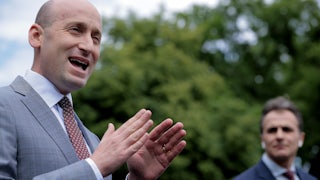Donald Trump has a health care plan. Or so we’ve been led to believe.
The president was set to unveil it at the White House on Monday, but then postponed the event, after details of the plan leaked to the media and rank-and-file Republicans—who felt blindsided, having not been briefed—revolted.
One provision in particular raised their ire: a two-year extension of the Obamacare subsidies that expire at year’s end, albeit with a few strings attached. Speaker Mike Johnson reportedly told Trump that the House GOP was opposed to the idea. “I wasn’t expecting the proposal to be Obamacare-lite,” a House Republican anonymously griped to MS NOW. “I don’t see how a proposal like this has any chance of getting majority Republican support. We need to be focused on health care, but extending Obamacare isn’t even serious.”
According to White House press secretary Karoline Leavitt, Trump has not given up his proposal but the details are still in flux. We can be reasonably confident of this much, though: Trump is not going to do a clean extension of the expiring subsidies, as that was not even the case in the plan that he is now presumably watering down to satisfy House Republicans. And that means chaos is assured for Americans who are shopping for—or already have chosen—a 2026 plan in the Affordable Care Act marketplaces.
“Every day that goes by, there are more people who are looking at their premiums and seeing them doubling, tripling, or more and deciding not to enroll,” said Gideon Lukens, a senior fellow and director of research at the Center on Budget Policy and Priorities. “So damage is being done every day.… There’s really only time to have a clean extension of the enhancements.”
Reuters reported Monday that a slew of states are lagging in ACA plan enrollment compared to a year ago. “People are making really tough choices to figure out how they can stay covered or making the tough choice to drop,” Ingrid Ulrey, chief executive officer for Washington Health Benefit Exchange, told the outlet. She said 7,000 people in her state have dropped coverage since open enrollment began.
Time is running out to avert a disaster. Congress is leaving town for Thanksgiving, and when it returns it will be in session for only three weeks. As part of the deal to reopen the government during the shutdown, Republicans promised Democrats a vote on a clean extension of the Obamacare subsidies—but even if they keep their promise, the vote is certain to fail, based on the reaction this week to Trump’s draft plan.
There were a few caveats to his proposed extension, of course. One was a new income limit: Anyone making more than 700 percent of the federal poverty line would no longer be eligible for the subsidies. Under the enhanced subsidies, which were enacted in 2021, anyone who paid more than 8.5 percent of their income toward premium costs would qualify for a subsidy for the rest. In practice very few, if any, high earners hit that barrier, but Trump’s proposed cap could hit families right on the threshold.
The plan would also require everyone to pay at least a little bit toward their premium. Republicans believe this solves the nonexistent problem of “phantom beneficiaries”: that people who sign up for insurance plans but never use their benefits are evidence of fraud. Such fraud would theoretically benefit brokers who sign up fake people for plans and earn a fee, or insurers who collect the premiums. But there’s no evidence that this type of fraud is widespread, and it’s common and expected for some people to not use their benefits over the course of the year.
Even small premium payments of $10 to $20 a month could be tough for low-income families with extremely tight budgets, especially as grocery and energy bills continue to skyrocket. But an even bigger problem could be that requiring payments creates another barrier to signing up for and maintaining insurance coverage, making it less appealing to younger adults who might not see the benefit, even at a very low cost. And this makes the ACA plans worse for everybody.
Before the enhanced subsidies were enacted, healthy people who made a little too much money to qualify for the subsidies, or whose subsidies didn’t cover enough of the cost, simply opted out of health insurance altogether. Meanwhile, people with more health problems stayed on insurance plans, which changed the risk pool and made those people more expensive to cover. And the more expensive health insurance becomes, the more people opt out: This is the “death spiral” that health care economists always warn about, and it’s why the ACA originally came with an individual mandate that penalized people for not having health insurance. (The Republicans zeroed out the penalty during Trump’s first term.)
MS NOW reported that Trump’s plan would also include health savings accounts, or HSAs, for people who choose bronze-level plans on the health insurance marketplaces. Bronze plans have lower monthly premiums but higher annual deductibles, meaning that many recipients pay less each month but must pay more out of pocket when they need care. Employers offer similar types of plans to their employees.
This is a retread of a long-simmering Republican idea that some senators have also proposed recently, and it isn’t a terrible one. Some people might choose to spend less each month and use tax-free savings accounts to save money in case something happens. It can be the best of both worlds: spending less each month while keeping a safety net if something terrible and unexpected happens, like a bad car accident. But it depends on how well designed the plan is.
Vivian Ho, a health economist at Rice University, pointed out that such a plan might also work for people who have a chronic condition and know roughly how much their health care will cost every year. “An HSA would allow them to save the right amount and leave them with predictable bills while saving money on premiums,” she said.
But HSAs are much more complicated than straightforward reductions in premium costs, and they require people to do more math and try to predict their future health care expenses. And if the government subsidies set aside for the HSAs aren’t as generous as the enhanced subsidies, they won’t be as helpful. They also don’t solve the death spiral problem, because these plans will still be most appealing to people who think they might need insurance over the next year.
Piling more people into the risk pool makes coverage per individual cheaper and helps bring down overall costs. Republicans sometimes frame this as unfair, as healthy people subsidizing unhealthy people. But it can be thought of another way: If everyone buys insurance while they’re relatively young and healthy, they are subsidizing the older version of themselves that needs medical care, because almost everyone is likely to experience an accident or health problem at least at some point in their lifetime. This is the way insurance works, and why it exists. People are bad at planning for the worst-case scenario.
The enhanced premium subsidies accomplished this because they lowered the upfront costs for insurance, changing the calculus for many people who had previously rolled the dice without insurance. Of course, the subsidies were a Covid-era patch for a deeply flawed health care system that is covered in patches. But they worked: By 2023, the U.S. had the lowest rate of uninsured Americans in history. And yet, unless Republicans pull off a highly unlikely legislative miracle, that may stand as the record low for many years to come.






